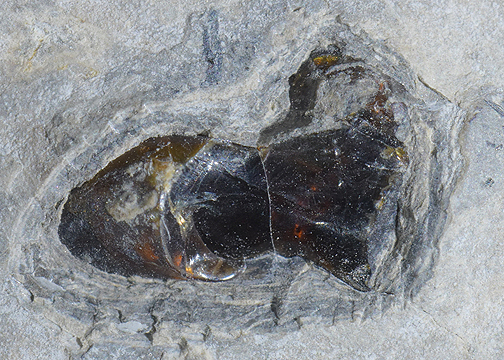Abstract
Globally, amber-rich strata are primarily found in major geological intervals, particularly the Aptian-Albian of the Early Cretaceous and the Eocene, both of which coincide with greenhouse climate conditions (Pearson et al., 2007; Katz et al., 2008; Delclòs et al., 2023). However, despite the relatively warm temperatures of the Paleocene, amber from this epoch remains exceptionally rare, with no confirmed records reported to date. This scarcity may be linked to the limited exposure of Paleocene strata worldwide. The Late Cretaceous Canadian Big Muddy amber deposit (ca. 67 Ma) which represents one of the closest known occurrences to the K-Pg boundary (Loewen et al., 2024). Here, we report the first-ever discovery of Palaeocene amber from the Sanshui Basin, China, filling a critical gap in the fossil resin record.
References
- Delclòs, X., Peñalver, E., Barrón, E., Peris, D., Grimaldi, D.A., Holz, M., Labandeira, C.C., Saupe, E.E., Scotese, C.R., Solórzano-Kraemer, M.M., Álvarez-Parra, S., Arillo, A., Azar, D., Cadena, E.A., Corso, J.D., Kvaček, J., Monleón-Getino, A., Nel, A., Peyrot, D., Bueno-Cebollada, C.A., Gallardo, A., González-Fernández, B., Goula, M., Jaramillo, C., Kania-Kłosok, L., Valle, R.L., Lozano, R P., Meléndez, N., Menor-Salván, C., Peña-Kairath, C., Perrichot, V., Rodrigo, A., Sánchez-García, A., Santer, M., Sarto i Monteys, V., Uhl, D., Viejo, J.L. & Pérez-de la Fuente, R. (2023) Amber and the Cretaceous resinous interval. Earth-Science Reviews, 243, 104486. https://doi.org/10.1016/j.earscirev.2023.104486
- Huang, D.Y., Lian, X.N., Corentin, J., Gao, J. & Nel, A. (2022a) First green lacewing (Insecta: Neuroptera: Chrysopidae) from the Palaeocene Sanshui basin of Guangdong, South China. Historical Biology, 34 (4), 704–712. https://doi.org/10.1080/08912963.2021.1943381
- Huang, D.Y., Lian, X.N. & Nel, A. (2025) A new damselfly family from the Palaeocene of the Sanshui Basin, South China (Odonata, Zygoptera). Journal of Paleontology. https://doi.org/10.1017/jpa.2024.43
- Huang, D.Y., Su, Y.T., Lian, X.N. & Gao, J. (2022b) Fossil caddis cases from the lower Eocene Huachong Formation of the Sanshui Basin, Foshan City, Guangdong Province, South China with detrital zircon analyses. Palaeoentomology, 5 (2), 105–112. https://doi.org/10.11646/palaeoentomology.5.2.2
- Katz, M.E., Miller, K.G., Wright, J.D., Wade, B.S., Browning, J.V., Cramer, B.S. & Rosenthal, Y. (2008) Stepwise transition from the Eocene greenhouse to the Oligocene icehouse. Nature Geoscience, 1, 329–334. https://doi.org/10.1038/ngeo179
- Loewen, E.J.T., Balkwill, M.A., Mattioli, J., Cockx, P., Caicedo, M.V., Muehlenbachs, K., Tappert, R., Borkent, A., Libke, C., Engel, M.S., Somers, C. & McKellar, R.C. (2024) New Canadian amber deposit fills gap in fossil record near end-Cretaceous mass extinction. Current Biology, 34, 1–10. https://doi.org/10.1016/j.cub.2024.03.001
- Nel., A. & Auvray, F. (2006) The oldest Vespinae from the Palaeocene of Menat (France) (Hymenoptera: Vespidae). Zootaxa, 1344, 59–62. https://doi.org/10.11646/zootaxa.1344.1.5
- Ni, Z.J., Song, X.B., Azar, D., Wang, Z.X., Cai, C.Y., Xuan, Q., Maksoud, S., Lian, X.N. & Huang, D.Y. (2023) Discovery of Late Cretaceous amber from Guangzhou, South China. Palaeoentomology, 6 (4), 329–332. https://doi.org/10.11646/palaeoentomology.6.4.3
- Pearson, P.N., Dongen, B.E. van, Nicholas, C.J., Pancost, R.D., Schouten, S., Singano, J.M. & Wade, B.S. (2007) Stable warm tropical climate through the Eocene Epoch. Geology, 35 (3), 211–214. https://doi.org/10.1130/G23175A.1
- Song, X.B., Sui, X., Xuan, Q., Azar, D., Cai, C.Y., Wang, Z.X. & Huang, D.Y. (2024) A new amber outcrop from the Late Cretaceous of Xingning Basin, South China. Palaeoentomology, 7 (6), 770–777. https://doi.org/10.11646/palaeoentomology.7.6.12
- Song, X.B., Lian, X.N., Yu, X.F., Wu, X.K., Wang, Y.H., Cai, C.Y., Xuan, Q., Gao, J., Azar, D., Ni, Z.J., Xu, M.M. & Huang, D.Y. (2025) Discovery of late Eocene amber from the Maoming Basin, Guangdong Province. Palaeoentomology, 8 (2), 129–137. https://doi.org/10.11646/palaeoentomology.8.2.3
- Wang, Y.Q., Li, Q., Bai, B., Jin, X., Mao, F.Y. & Meng, J. (2019) Paleogene integrative stratigraphy and timescale of China. Science China Earth Science, 62, 287–309. https://doi.org/10.1007/s11430-018-9305-y
- Wappler, T., Currano, E.D., Wilf, P., Rust, J. & Labandeira, C.C. (2009) No post-Cretaceous ecosystem depression in European forests? Rich insect-feeding damage on diverse middle Palaeocene plants, Menat, France. Proceedings of Royal Society of London, B, 276, 4271–4277. https://doi.org/10.1098/rspb.2009.1255
- Zhang, X.Q., Li, G., Yang, R.L. & Li, H.M. (2008) Palaeogene ostracods from the Sanshui Basin of Guangdong. Acta Micropalaeontologica Sinica, 25 (3), 235–265.
- Zhang, X.Q., Zhou, X.P. & Chen, X.Y. (1993) Atlas of Cretaceous to Tertiary strata classification and correlation in the Sanshui Basin of South China. Marine Press, Beijing, 183 pp.
- Zhang, Z.J., Wang, X., Liu, Z. & Zhang, X.Q. (2022) A brief report on the Palaeocene insects from the Sanshui Basin of Guangdong, South China. Palaeoentomology, 5 (2), 167–172. https://doi.org/10.11646/palaeoentomology.5.2.10
- Zhou, H.M., Xiao, L., Dong, Y.X., Wang, C.Z., Wang, F.Z. & Ni, P.Z. (2009) Geochemical and geochronological study of the Sanshui basin bimodal volcanic rock suite, China: Implications for basin dynamics in southeastern China. Journal of Asian Earth Sciences, 34, 178–189. https://doi.org/10.1016/j.jseaes.2008.05.001


